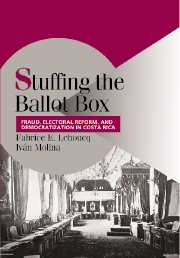Book contents
- Frontmatter
- Contents
- List of Tables and Figures
- Preface
- INTRODUCTION
- 1 ELECTORAL FRAUD DURING INDIRECT AND PUBLIC ELECTIONS, 1901–12
- 2 INSTITUTIONAL CHANGE, ELECTORAL CYCLES, AND PARTISANSHIP, 1910–4
- 3 ELECTORAL FRAUD DURING THE PUBLIC BALLOT,1913–23
- 4 INSTITUTIONAL CHANGE, ELECTORAL CYCLES, AND PARTISANSHIP, 1924–8
- 5 ELECTORAL FRAUD DURING THE SECRET BALLOT, 1925–48
- 6 POLITICAL POLARIZATION, ELECTORAL REFORM, AND CIVIL WAR, 1946–9
- CONCLUSION: BALLOT-RIGGING AND ELECTORAL REFORM IN COMPARATIVE PERSPECTIVE
- Index
- Cambridge Cultural Social Studies
3 - ELECTORAL FRAUD DURING THE PUBLIC BALLOT,1913–23
Published online by Cambridge University Press: 16 July 2009
- Frontmatter
- Contents
- List of Tables and Figures
- Preface
- INTRODUCTION
- 1 ELECTORAL FRAUD DURING INDIRECT AND PUBLIC ELECTIONS, 1901–12
- 2 INSTITUTIONAL CHANGE, ELECTORAL CYCLES, AND PARTISANSHIP, 1910–4
- 3 ELECTORAL FRAUD DURING THE PUBLIC BALLOT,1913–23
- 4 INSTITUTIONAL CHANGE, ELECTORAL CYCLES, AND PARTISANSHIP, 1924–8
- 5 ELECTORAL FRAUD DURING THE SECRET BALLOT, 1925–48
- 6 POLITICAL POLARIZATION, ELECTORAL REFORM, AND CIVIL WAR, 1946–9
- CONCLUSION: BALLOT-RIGGING AND ELECTORAL REFORM IN COMPARATIVE PERSPECTIVE
- Index
- Cambridge Cultural Social Studies
Summary
Introduction
Though parties did not overhaul the political architecture of the republic, they had amended the constitution so that citizens could directly elect presidents and deputies. They no longer had to struggle to maintain the loyalty of several hundred electors in the time period between popular and second-stage elections. With the establishment of direct elections, parties instead had to compete in a market for the support of an electorate rapidly expanding to include more than one hundred thousand men by the 1920s. How did this affect their efforts to stuff the ballot box?
In research Dana Munro conducted in the 1910s, he suggested that such changes had not fundamentally altered the relationship between parties and voters. “The representatives [that every party has] at the polls,” he argued, “prevent fraudulent counting, but encourage corruption and the exercise of improper influence on the individual elector.” Nevertheless, in comparison to other countries in Central America, Munro claimed “the amount of intimidation and coercion … is insignificant …, and attempts to influence voters by such means are generally condemned by public opinion.”
Munro's observations are both helpful and frustrating. On the one hand, they suggest that the establishment of direct elections had not decisively changed politics. On the other hand, Munro's remarks raise the question of whether these elections were meaningful political contests or elite-dominated affairs.
- Type
- Chapter
- Information
- Stuffing the Ballot BoxFraud, Electoral Reform, and Democratization in Costa Rica, pp. 86 - 117Publisher: Cambridge University PressPrint publication year: 2002



